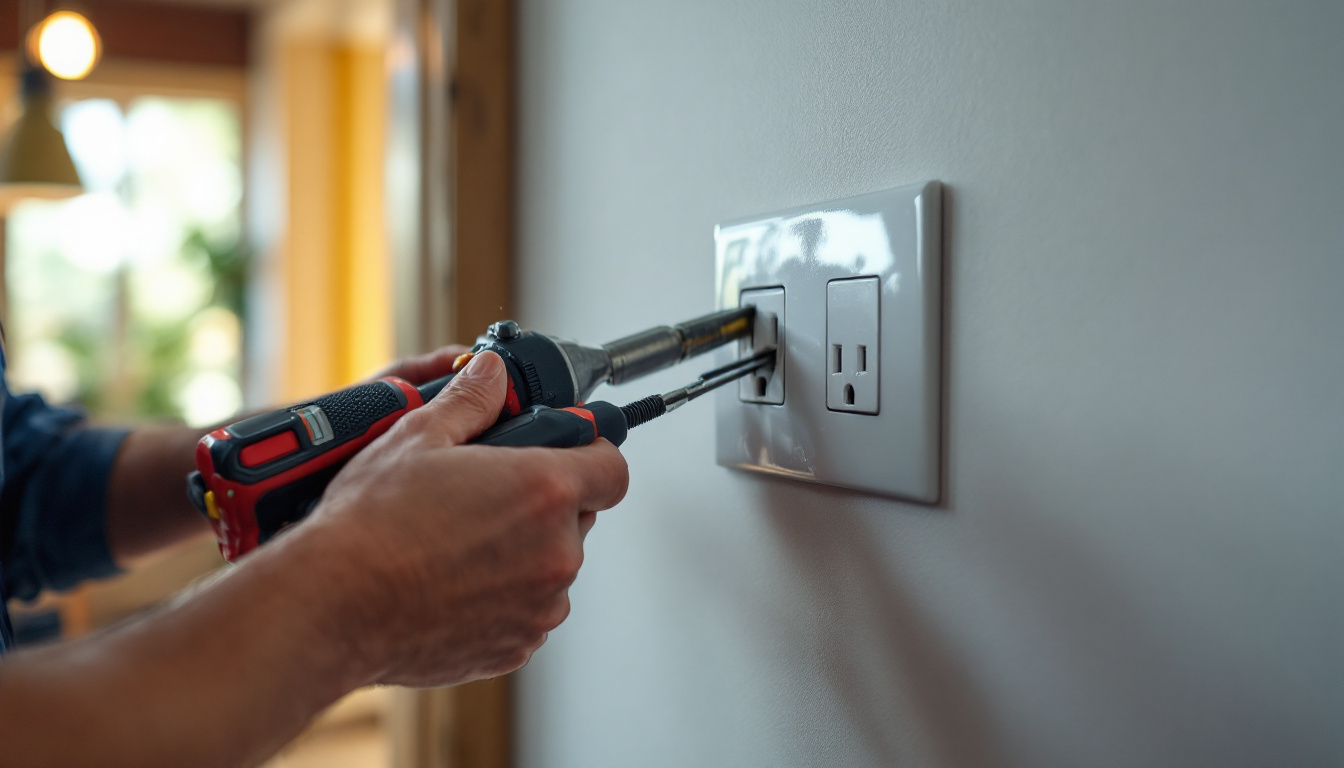

Motion lights have become a staple in modern lighting solutions, providing both convenience and security. These lights are designed to automatically turn on when they detect movement, making them ideal for various applications, from outdoor security to indoor convenience. The integration of motion sensors into lighting systems not only enhances safety but also contributes to energy efficiency by ensuring lights are only on when needed.
In many lighting projects, however, the inclusion of a switch alongside motion lights is often overlooked. This combination can significantly enhance functionality and user control, making it a crucial consideration for lighting contractors. Understanding how to effectively implement motion lights with a switch can elevate a project from ordinary to exceptional.
One of the primary advantages of motion lights is their ability to deter intruders. By illuminating a space when movement is detected, they create a perception of occupancy, which can be a powerful deterrent. However, the addition of a manual switch allows users to have control over the lighting, enabling them to turn the lights on or off as needed. This is particularly useful in scenarios where constant illumination is desired, such as during outdoor gatherings or when working in a garage.
Moreover, the convenience of having a switch means that users can override the motion sensor when necessary. For instance, if someone is working in an area where movement is minimal but lighting is still required, the switch provides a simple solution. This flexibility is essential for creating a user-friendly lighting environment. Additionally, many modern motion lights come equipped with adjustable sensitivity settings, allowing users to fine-tune how responsive the lights are to movement. This feature can be particularly beneficial in areas with frequent foot traffic, such as driveways or pathways, where false triggers can lead to unnecessary light activation.
Energy efficiency is a significant concern in today’s lighting projects. Motion lights inherently contribute to this goal by only activating when movement is detected. However, when paired with a switch, the energy-saving potential increases. Users can manually turn off lights when they are not in use, preventing unnecessary power consumption.
Furthermore, the integration of a switch allows for the customization of lighting schedules. For example, in commercial settings, a contractor can program motion lights to operate during business hours while allowing users to manually control them after hours. This not only saves energy but also reduces operational costs, making it an attractive option for businesses. In residential settings, homeowners can benefit from programmable timers that work in conjunction with motion sensors, ensuring that lights are only active during peak hours or when the family is home. This level of control not only enhances energy efficiency but also promotes a sustainable lifestyle, encouraging users to be more mindful of their energy consumption habits.
When considering motion lights with switch options, various types are available, each catering to different needs and preferences. Understanding these options can help contractors choose the best fit for their projects.
Outdoor motion lights are commonly used for security purposes. These fixtures are designed to withstand the elements while providing bright illumination when movement is detected. Many outdoor models come equipped with a switch, allowing homeowners to control the lights manually when desired. This feature is particularly useful for pathways, driveways, and entryways, where constant lighting may be required during specific times.
Incorporating a switch into outdoor motion lights also allows for enhanced functionality. For instance, during outdoor events, users can keep the lights on continuously without relying solely on the motion sensor. This flexibility can be a selling point for contractors looking to provide comprehensive lighting solutions. Additionally, many outdoor motion lights now come with adjustable sensitivity settings, allowing users to fine-tune how easily the lights activate. This is particularly beneficial in areas with frequent animal movement, preventing unnecessary activation and extending the lifespan of the bulbs.
Indoor motion lights serve various purposes, from enhancing security in hallways to providing convenience in garages and basements. These lights can be integrated with a switch to allow for manual control, ensuring that users have the option to keep lights on during activities that require consistent illumination.
Moreover, indoor motion lights can be particularly beneficial in spaces where hands-free operation is essential. For example, in a laundry room or utility area, users can simply walk in, and the lights will activate. However, the addition of a switch allows for customization, enabling users to turn the lights off when not needed, thus saving energy. Furthermore, many indoor motion lights are designed with sleek aesthetics in mind, making them suitable for modern home decor. Some models even feature adjustable brightness levels, allowing users to set the ambiance according to their needs, whether for a cozy movie night or a bright workspace.
With the rise of smart home technology, smart motion lights have gained popularity. These fixtures can be controlled via smartphone apps or voice commands, providing unparalleled convenience. Many smart motion lights also feature manual switches, allowing users to switch between automated and manual control easily.
Smart motion lights can be programmed to operate based on specific schedules or routines, enhancing energy efficiency and convenience. For contractors, recommending smart motion lights with switch options can appeal to tech-savvy clients looking to enhance their home automation systems. Additionally, some smart motion lights come with advanced features such as integration with security cameras, allowing homeowners to receive alerts when motion is detected. This added layer of security can be a significant selling point, as it not only illuminates spaces but also enhances overall safety. With customizable settings, users can adjust the sensitivity and duration of the lights, ensuring that they meet their specific needs while seamlessly fitting into their daily routines.
When installing motion lights with switches, several factors must be taken into account to ensure optimal performance and user satisfaction. Proper installation not only enhances functionality but also ensures safety and compliance with electrical codes.
Wiring is a critical aspect of installing motion lights with switches. Contractors should ensure that the wiring is done correctly to prevent any electrical issues. It is essential to follow local electrical codes and guidelines during installation. Additionally, the placement of both the motion sensor and the switch should be carefully considered to maximize effectiveness.
For outdoor installations, motion sensors should be positioned to cover the desired area without being obstructed by trees or structures. Similarly, indoor motion lights should be placed in areas where movement is expected, such as hallways or entryways. The switch should be easily accessible to users, allowing for seamless operation.
Once installed, testing and calibration are vital steps in ensuring that motion lights function as intended. Contractors should test the motion sensors to confirm that they activate at the appropriate distance and angle. Additionally, the switch should be tested to ensure it operates smoothly, allowing users to toggle the lights on and off without any issues.
Calibration may also involve adjusting the sensitivity of the motion sensor. Depending on the environment, some sensors may need to be set to a higher or lower sensitivity to prevent false activations or missed detections. This fine-tuning can significantly enhance user experience and satisfaction.
While motion lights with switches offer numerous benefits, contractors may encounter challenges during installation and operation. Understanding these challenges and their solutions can help ensure a successful project.
One common issue with motion lights is false activations, which can occur due to pets, passing vehicles, or other environmental factors. This can lead to unnecessary energy consumption and frustration for users. To mitigate this issue, contractors should recommend motion sensors with adjustable sensitivity settings.
Additionally, positioning the sensors strategically can help reduce false activations. For example, placing sensors higher or angling them away from busy areas can minimize the chances of detecting non-target movements. Educating clients about the importance of proper placement can also enhance their satisfaction with the lighting system.
Inconsistent performance can be another challenge, particularly with outdoor motion lights exposed to varying weather conditions. Factors such as rain, snow, or extreme temperatures can affect the functionality of the sensors. To address this, contractors should choose high-quality, weather-resistant motion lights designed to withstand the elements.
Regular maintenance is also crucial. Educating clients about the importance of keeping the sensors clean and free from obstructions can help ensure consistent performance. This proactive approach can prevent issues and enhance the longevity of the lighting system.
Incorporating motion lights with switches into lighting projects can significantly enhance functionality, convenience, and energy efficiency. For contractors, understanding the benefits, types, installation considerations, and potential challenges associated with these systems is essential for delivering exceptional results.
As the demand for smart and efficient lighting solutions continues to grow, offering motion lights with switches can set a contractor apart in a competitive market. By providing clients with the flexibility to control their lighting, contractors can ensure satisfaction and foster long-term relationships.
Ultimately, the missing piece in many lighting projects lies in the thoughtful integration of motion lights with switches. By recognizing and addressing this need, contractors can create innovative and effective lighting solutions that meet the diverse needs of their clients.
Ready to enhance your lighting projects with the functionality, convenience, and energy efficiency of motion lights with switches? Look no further than LumenWholesale, where we provide contractors with top-quality, spec-grade lighting products at unbeatable wholesale prices. Say goodbye to inflated markups and hello to superior lighting solutions that meet the highest industry standards. With our hassle-free bulk buying and free shipping, you can trust that you’re getting premium lighting at the best value — without hidden fees or compromises. Elevate your lighting projects today and experience the best in wholesale lighting with LumenWholesale.

Discover essential tips and expert insights for lighting contractors looking to master the art of post lantern installation.

Explore the advantages and drawbacks of RGB LED lights for lighting contractors.

Discover how LED workshop lights can transform your workspace with superior illumination.

Discover essential insights for lighting contractors on electrical outlets, including installation tips, safety guidelines, and the latest industry standards.
Get notified when NEW deals are released.
Optimize your budget with wholesale discounts.
Only top-quality, specification-grade lighting products.
No additional costs at checkout - what you see is what you pay.
We understand the unique needs of contractors.